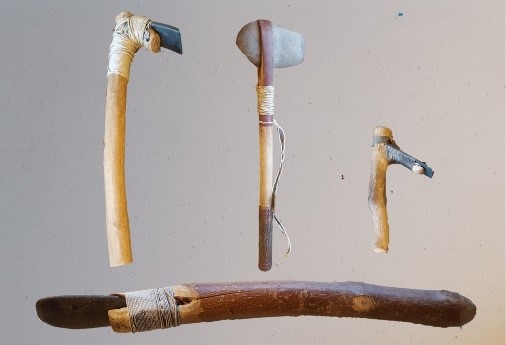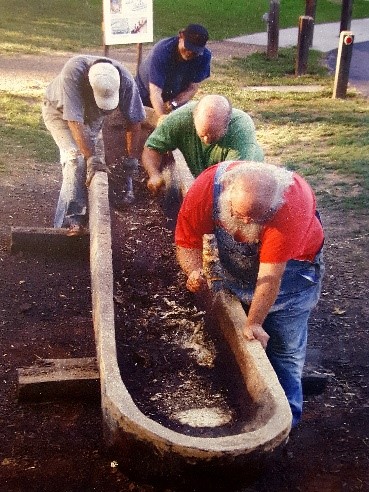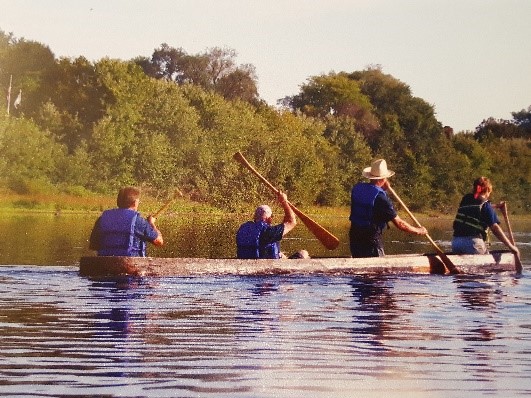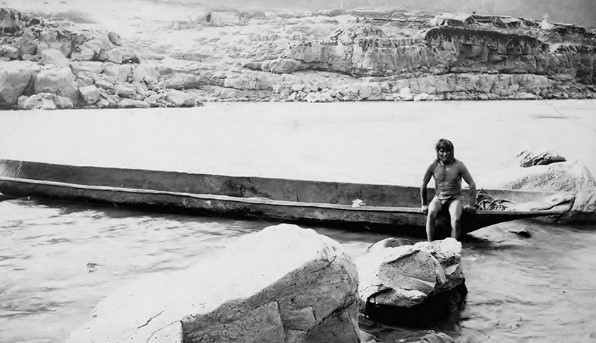RiverRoots: Dugout Canoes on the Susquehanna
RiverRoots: Dugout Canoes on the Susquehanna
River Roots is Susquehanna NHA’s blog series featuring history from York and Lancaster Counties that showcases the Susquehanna River’s historic, cultural, and natural resources contributions to our nation’s heritage.
This week we explore dugout canoes on the Susquehanna River. Long before powerboats and jet skis, before mule-drawn canal boats, and before Anderson’s, Wright’s and Cresap’s ferries, dugout canoes were the favored way of navigating the Susquehanna’s shallow waters.
Dugout Canoes on the Susquehanna

Unlike the birchbark canoes used by many northern American Indians, dugouts were heavy, slow, and unsuitable for long distance travel. But the swift, rocky, Susquehanna was not suited for travel in more fragile birchbark canoes, and birch trees with suitable bark were not found here. So, the lower Susquehanna’s native peoples relied on their network of footpaths to traverse the land. However, for fishing and carrying cargoes of meat and hides, and people, across the river, dugouts were ideal.
Dugout canoes have been used by indigenous peoples worldwide for thousands of years. Specimens recovered in the northeast United States have been found dating as far back as 6,000 years before the present. They were undoubtedly being constructed thousands of years earlier.
Based on historic accounts, most dugouts were less than 20 feet long, but some were reported to be 50 feet or larger. In the southeastern United States, 16th century Spanish explorer Hernando De Soto encountered dugouts on the Mississippi River carrying 75 to 80 warriors with 25 paddlers on each side. These vessels may have approached 100 feet in length. Some southeastern dugouts were painted, and some were carved with designs of snakes and fishes. Dugouts from the Mississippi Valley sometimes had decks, seats, or awnings. Early English reports from the Chesapeake mention canoes 40-50 feet long able to carry about one passenger per foot of length. English explorer John Smith reported some in the Chesapeake as being 3-4 feet deep.

Nearly 20 dugout canoes have been found in bogs and lakes in Pennsylvania, primarily in the Pocono region. No archaeological evidence of dugouts has been found along the Susquehanna, but Smith’s journal of his travels on the Chesapeake Bay does mention Susquehannock “canowes”:
“Five of their chiefe Werowances came boldly aboord us to crosse the Bay for Tockwhogh, leaving their men and Canowes…”
We assume the canoes were dugouts, as he describes the canoes of another, distant tribe as being “small boats, made of the barkes of trees”. We can also make the argument that the Susquehannocks didn’t paddle their canoes from their town at today’s Washington Boro to the mouth of the Susquehanna. Paddling down the Susquehanna would be possible, but paddling back through rapids, or portaging around them, would have been an ordeal. Walking, at least upriver, would be faster, and leaving their dugouts at the bay wouldn’t make sense. Finally, Smith makes no mention of them arriving to the river’s mouth in canoes.
Dugouts were typically left where they were used, be it lake or river, and the Susquehannock frequented the Bay, so no doubt they kept dugouts along its shores for their use. There is evidence to suggest that they may have been sunk with rocks when not being used to keep them from drying out and cracking, and perhaps to hide them from potential thieves.
Making the Dugout
Most simply put, a dugout canoe is just a hollowed-out log. But the process for making one isn’t quite so simple. Consider the work involved. First, tools for the job need to be fashioned. Although by the time the Susquehannock tribe arrived on the lower Susquehanna, metal tools were being obtained from European traders, stone tools were still in use. Several types of tools may have been used in dugout canoe construction – axes, handled adzes, hand adzes, and smoothing stones, for example. For a cutting tool, the proper type of stone (meta-basalt and meta-rhyolite work well) must first be found. Working the rough stone into a sharp tool required flaking, pecking, grinding, and polishing to the proper shape and edge, a process that could take in excess of eight hours. Axes and adzes had to be hafted onto a wooden handle, a technical process in itself. Next, a tree, of the proper size and type (commonly, white pine), must be selected. Felling the tree could be accomplished by chopping, but burning a controlled fire at its base may have required less labor.
 |
Tools used in dugout canoe construction (Clockwise from bottom: hafted scraper, adze, hand axe, finishing adze) |
In order to better understand the effort, tools, and techniques required to create a dugout canoe, archaeologists from the Pennsylvania Historical and Museum Commission (PHMC) have employed experimental archaeology to produce several full-size replicas using the same tools and techniques American Indians used those many years ago. One of the dugouts is a popular annual attraction at the Pennsylvania Farm Show and has also been on display at SNHA’s Columbia Crossing River Trails Center. The archaeologists based their design on a dugout discovered in 1935 by a group of boys in Mud Pond near Pleasant View Summit, in eastern Luzerne County, and donated to the State Museum of Pennsylvania in 1968. The dugout, dating to circa 1250 AD, is now exhibited in the museum’s Anthropology Hall.
The archaeologists were aided by early descriptions and illustrations of Native American vessels, including the well-known 16th century accounts by British explorers John White and Arthur Barlowe of dugout canoes used in what would become Virginia and North Carolina. Both White and Barlowe describe a process of burning and scraping with shells to fashion dugouts. Other than for cutting down the tree, they do not reference the use of stone axes or adzes. In his report of the 1584 reconnaissance of what is now coastal North Carolina, Arthur Barlowe described the process this way:
“Their boates are made of one tree, either of Pine, or of Pitch trees: a wood not commonly knowen to our people, nor found growing in England. They have no edge tooles to make them withall…they burne downe some great tree, or take such as are winde fallen, and putting myrrhe [sic], and rosen upon one side thereof, they sette fire into it, and when it hath burnt it hollowe, they cutte out the coale with their shels, and ever where they would burne it deeper or wider, they laye on their hummes, which burneth away the timber, and by this meanes they fashion very fine boates, and such as will transport twentie men.”
 |
| The manner of makinge their boates, Theodor de Bry engraving after John White watercolor, c.1590. This hand-colored engraving is from The Briefe and True Report of the New Found Land of Virginia…, Thomas Hariot, 1588. The Mariners’ Museum Library, Newport News, Virginia) |
For the replica, a 20-foot long white pine log measuring nearly three feet in diameter was secured. The log came from a tree in Michaux State Forest that had been blown down in a storm. Over the course of seventeen days a crew of at least three people worked six to eight hours a day to complete the task. Each morning, a fire was started the length of the dugout and allowed to burn for two to four hours. Clay was applied around the fire to control the burn. When the fire was extinguished, the charred material was completely removed by scraping with beveled pieces of wood and finally with the stone adzes. The worked progressed slowly, with less than one inch of material being removed each day. After the interior was finally roughed out, it was rubbed with pieces of sandstone to reduce splinters and increase comfort. The last step was to apply a coat of pine tar mixed with hot wood ash to serve as a sealer. The maiden voyage for the dugout came on October 2, 2005, when a crew of four archaeologists paddled down the Susquehanna from Fort Hunter to City Island in Harrisburg. They described the canoe as stable, but not agile. Although it took some work to get it moving, once underway its momentum kept it going without undo effort.
 |
 |
| PHMC archaeologists making replica dugout (left) and taking on its maiden voyage. (right) | |
Dugouts after European Arrival

Dugout canoes were so sturdy, dependable, and well-suited to their purpose that the coastal Indians were slow to adopt white settlers’ planked boats. With a full complement paddling, a canoe could overtake or pull away from an English boat of comparable size under oars. Additionally, because of their narrow beam and shallow draft, canoes could easily ply waters closed to many of the small crafts used by the English. Colonists quickly adopted the canoe and even adapted it to sail. On the Susquehanna, John Wright’s ferry operation used dugout canoes lashed together to transport wagons across the river, and dugouts continued to be made and used by European settlers well into the 1800s.
To Learn More
Check out the The 2005 Pennsylvania Dugout Canoe Project. This detailed PowerPoint Presentation shows images and details about the tools and process used by the Pennsylvania Historical & Museum Commission.
Resources
Carr, Kurt W., et al. The Pennsylvania Dugout Canoe Project Pennsylvania Historical and Museum Commission Bureau for Historic Preservation, 2006
Indian Canoes of Eastern North Carolina
Smith, John. General History of Virginia…., 1624.
Stick, David. Indian Canoes in Coastal North Carolina 400 Years Ago, 1983
